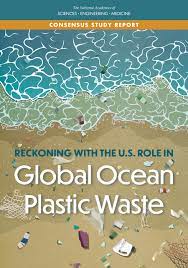From an Article by Brett Wilkins, Common Dreams News, December 1, 2021
The National Academies of Sciences, Engineering, and Medicine study found that the U.S. is responsible for about a quarter of the plastics that enter the world’s oceans each year. As the world’s leading marine plastics polluter, the U. S. should devise a “national strategy” by the end of next year to address the crisis, according to a new report published Wednesday by the National Academies.
The congressionally mandated report — entitled “Reckoning With the U.S. Role in Global Ocean Plastic Waste” — revealed that at least 8.8 million tons of plastics enter the world’s oceans each year, with about a quarter of that amount coming from the United States.
“Plastic waste is an environmental and social crisis that the U.S. needs to affirmatively address from source to sea,” Monterey Bay Aquarium chief conservation and science officer Margaret Spring — who chaired the study committee — said in a statement.
“Plastic waste generated by the U.S. has so many consequences,” she added, “impacting inland and coastal communities, polluting our rivers, lakes, beaches, bays, and waterways, placing social and economic burdens on vulnerable populations, endangering marine habitats and wildlife, and contaminating waters upon which humans depend for food and livelihoods.”
The report lists six steps that can be taken to begin to address the marine plastics crisis:
1. Reducing plastic manufacturing—especially for single-use and nonrecyclable products;
2. Innovating design and materials to develop substitutes that degrade more quickly or can be more easily recycled or reused;
3. Decreasing waste generation by reducing the use of disposable plastics;
4. Improving waste management including infrastructure, collection, treatment, leakage control, and accounting;
5. Capturing waste in the environment; and
6. Minimizing the maritime disposal of plastics.
The marine conservation group Oceana said in a statement that “there isn’t a place on Earth untouched by plastic.”
“Plastic has now been found everywhere, including in the most unexpected places: Arctic sea ice, the Mariana Trench, air in the remotest of mountains, rain in our national parks, and our food, including honey, salt, water, and beer,” the group continued. “Scientists are still studying what all this means for human health. With plastic production growing at a rapid rate, increasing amounts of plastic can be expected to flood our blue planet with devastating consequences.”
Oceana plastics campaign director Christy Leavitt said that “we can no longer ignore the United States’ role in the plastic pollution crisis, one of the biggest environmental threats facing our oceans and our planet today.”
“This report shows that much of the plastic waste that threatens critical ecosystems, wildlife, and human health around the globe originates here in the U.S., and our country’s leaders have a responsibility to change that,” she argued.
“A national solution is already mapped out, thanks to the introduction of the Break Free From Plastic Pollution Act earlier this year,” Leavitt continued, referring to a bill sponsored by Sen. Jeff Merkley (D-Ore.) and Rep. Alan Lowenthal (D-Calif.). “Now it’s time for members of Congress to pass it,” she added, “so we can stop wasting time with inadequate solutions and finally tackle the plastics problem with the comprehensive approach and source reduction it requires.”
The report comes less than two weeks after the Biden administration — in sharp contrast to the Trump era — announced support for developing a global treaty to tackle marine plastic pollution, a move that was applauded by environmentalists.
Suggested Citation — National Academies of Sciences, Engineering, and Medicine. 2021. Reckoning with the U.S. Role in Global Ocean Plastic Waste. Washington, DC: The National Academies Press.https://doi.org/10.17226/26132. $60.00 paperback.
>>>>>>………………>>>>>>………………>>>>>>
See Also: Great Pacific Garbage Patch Becomes an Ocean Habitat for Coastal Species — Olivia Rosane, EcoWatch, December 02, 2021
The North Pacific Subtropical Gyre, or the “Great Pacific Garbage Patch,” stretches for more than 610,000 square miles between California and Hawai’i. The gyre hosts around 79,000 metric tons of microplastics, nets, buoys and bottles. And, in a surprising turn, coastal life.
Scientists writing in Nature Communications Thursday have found coastal animals like anemones, hydroids and shrimp-like amphipods living on plastic collected from the open ocean.
“Floating plastic debris from pollution now supports a novel sea surface community composed of coastal and oceanic species at sea that might portend significant ecological shifts in the marine environment,” the study authors wrote.

